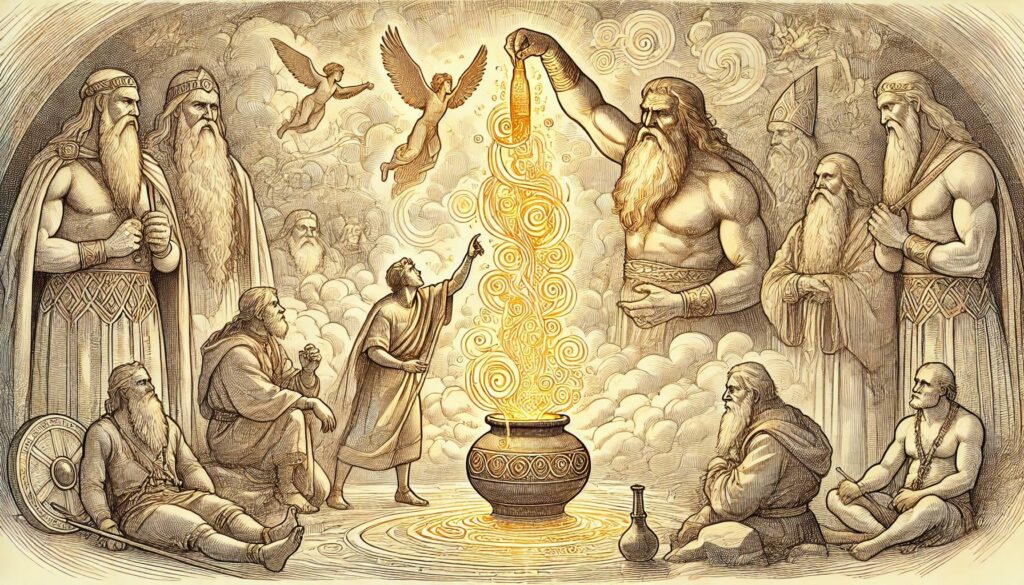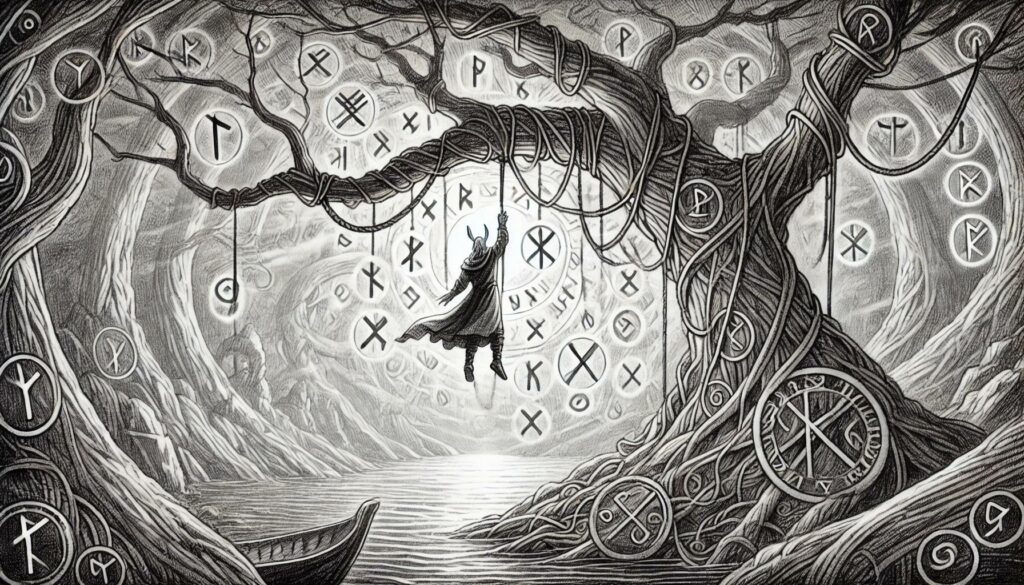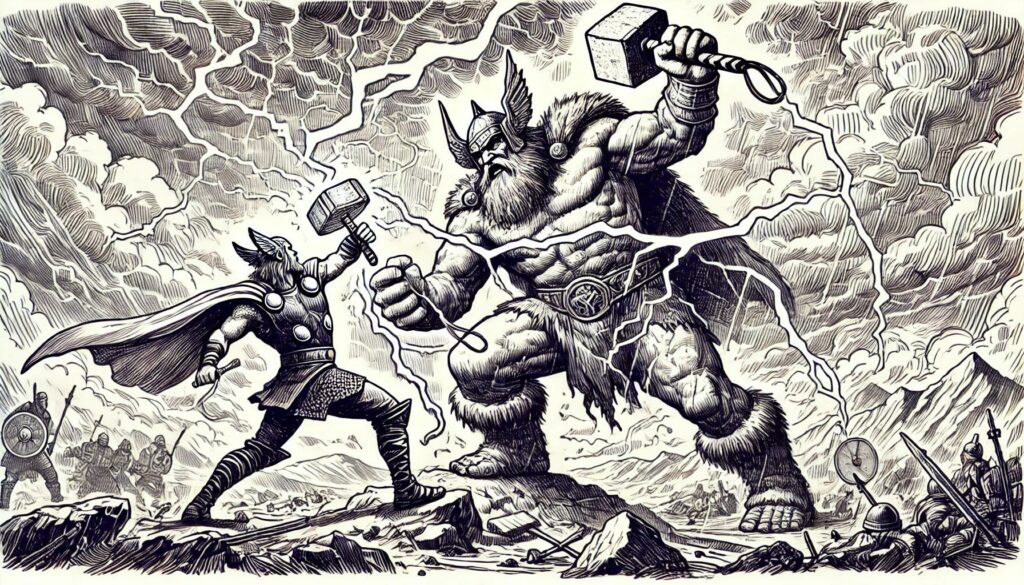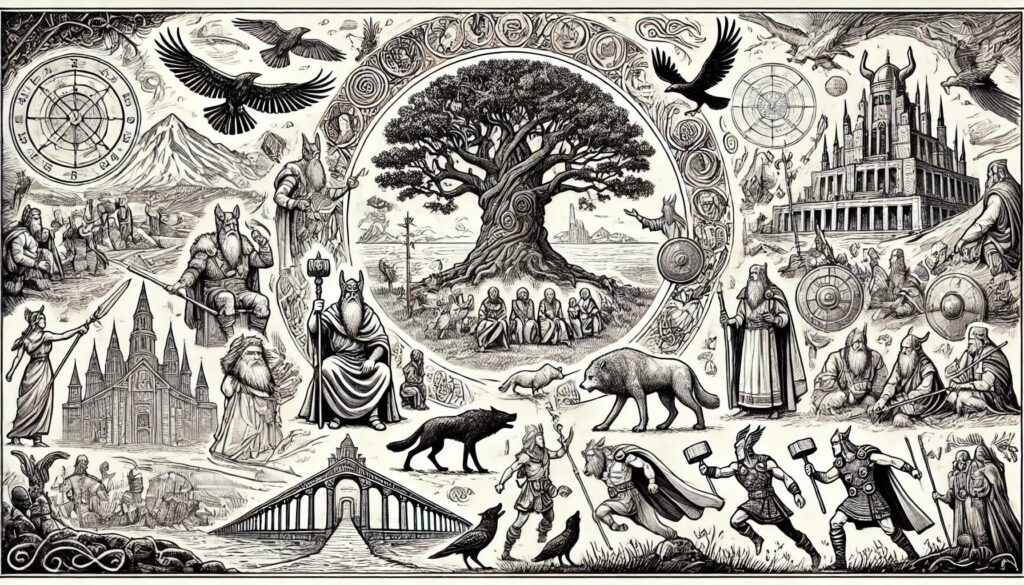Tales of the Gods
Tales of the Gods
In Norse mythology, the stories of gods and goddesses come alive. They are set in Asgard, a vast and mythical place. Here, we learn about the lives and adventures of powerful divine beings.
Thor shows us unmatched strength, while Odin teaches us the value of wisdom. These characters’ stories show us courage, honor, and the role of destiny. Even today, their myths influence our history and culture, leaving a lasting impression on us.
Introduction to Norse Mythology
Norse mythology is a collection of ancient stories. They come from the beliefs of people in the Viking Age Scandinavia. These tales give us a look into the spiritual and cultural life of the Old Norse people, offering glimpses of life through their sagas. By exploring them, we see the values and traditions of this strong seafaring society.
Significance of Norse Myths
The Norse myths are more than just stories. They show us how the Old Norse people saw the world, their gods, and their heroes. These myths connect us to the past and the real history of the Viking Age. They help us understand the moral values that guided the Scandinavians.
Today, Norse myths are still influential. They are seen in literature, art, movies, and video games. They keep us connected to our ancient beginnings, as captured in many myths and legends. They remind us of the timeless stories about gods, giants, and magical creatures, tales of the Norse passed down through generations.
Sources of Norse Myths
To understand Norse mythology, we turn to its primary sources. The Poetic Edda and the Prose Edda are key texts. They keep the Norse oral traditions alive. The Poetic Edda has epic poems, and the Prose Edda by Snorri Sturluson offers a more organized look at the myths in noble collectible editions.
These texts are important because they tell us about the culture of the Viking Age Scandinavians. They pass down the stories of gods, giants, and magical creatures, enriching our culture with myths and legends. Without these texts, we would know much less about Norse mythology.
Key Norse Myths
In Norse mythology, we learn about fascinating tales that explore the cosmos and the divine. These stories are rich with gods, their relationships, and the legendary items they use. We find out how the world was created, what connects the nine realms, and the role of gods in Norse culture.
The Creation of the Cosmos
The Norse creation myth starts with Ginnungagap, a void between fire (Muspelheim) and ice (Niflheim). A giant, Ymir, is born from these elements, and his body shapes the world, a foundational saga in Norse lore. This begins the Norse view of the cosmos, with Yggdrasil connecting the nine realms.
The Aesir-Vanir War
The Aesir and Vanir, powerful godly groups, once fought but later made peace. This war and its end highlight themes of unity and reconciliation among gods. They exchanged blessings of peace, which marked a key moment in their myths and showed how gods interact.
The Mead of Poetry
The Mead of Poetry, made from Kvasir’s blood, gives its drinkers wisdom and skill with words, revered by the Scandinavians of the Viking age. Odin, in a clever move, secures it for the gods. This myth highly values knowledge and poetry’s art among the Norse gods.

The Treasures of the Gods
Divine artifacts like Thor’s Mjölnir, Odin’s Gungnir, and Draupnir, a magical ring, stand out. These objects are more than just powerful symbols. They are essential in significant tales, reflecting the gods’ abilities and wit.
The Fortification of Asgard
The building of Asgard’s protective wall shows the gods’ initiatives to protect their home. They hire a master builder, but things go wrong when the builder is outsmarted. This story underscores the gods’ wisdom and their efforts to keep their world safe.
Famous Tales of the Gods
Norse mythology brims with stories of the gods’ bravery, self-sacrifice, and deep knowledge, which shed light on the Viking Age’s culture and beliefs.
How Odin Lost His Eye
Odin’s story of losing his eye is well-known. Seeking wisdom, he gave up one eye at Mimir’s well. This noble act shows his endless quest for understanding and his dedication to the world’s well-being.
Odin Discovers the Runes
The finding of the runes is an intriguing tale. Odin hung from Yggdrasil, the World Tree, for nine days without food or water to gain wisdom. This hardship revealed the runic alphabet, an important element in Viking culture and daily life.

The Kidnapping of Iduna
Iduna’s magical apples kept the gods young and powerful. When the giant Thjazi kidnaps her, Loki rescues her. This story shows the gods’ efforts to guard their vital resources.
The Marriage of Njord and Skadi
The Marriage of Njord and Skadi is fascinating. Njord, representing the sea, and Skadi, the mountains, had a hard time together. Their story displays nature’s intertwining and the many challenges in Viking beliefs.
The Binding of Fenrir
Fenrir, a wolf, was feared for the chaos he was destined to cause. The gods bound him to prevent this destruction. It symbolizes the constant battle between order and disorder in Norse myths.
Thor’s Adventures
Thor stood as the god of thunder in Norse mythology. His adventures are exciting tales loved by many. They show his strength and courage. Let’s look into some of his most famous stories.
Thor’s Journey to Utgard
Thor went on a long journey to Utgard, the land of giants. There, he met Utgard-Loki. Thor had to prove his strength and cleverness to defeat the giants, reflecting the heroic feats in the tales of Norse mythology. His hammer, Mjolnir, helped him through many challenges.
Thor’s Fishing Trip
Thor went fishing to catch the powerful Midgard serpent. With Mjolnir in hand, he tries to pull the serpent out of the sea. This adventure shows his great strength and courage in the face of danger, echoing the tales of Norse mythology.
Thor’s Wedding Day
On his wedding day, Thor had to get his stolen hammer back. He cleverly dressed up as a bride to trick the giants. This story mixes bravery with humor. It shows Thor in a funny and clever light, a beloved character in the tales of Norse mythology.
Thor’s Duel with Hrungnir
Thor battled Hrungnir, a strong giant, to protect Asgard. When Hrungnir attacked, Thor fought him to save his people. He showed his great strength and willpower in the fight. This event made him a true hero in Norse myths.

Tragic Tales
In Norse mythology, you’ll find stories full of bravery and tragedy. One of the most heart-wrenching is the story of Baldur and Loki. These tales show deep emotions and lead to an epic battle known as Ragnarok.
The Death of Baldur
Baldur was a god cherished for his light and goodness. Yet, he dreamt of his own death. This filled the gods with fear because Norse prophecy always comes true. His mother, Frigg, tried to protect him by making everything promise not to hurt Baldur. Unfortunately, she forgot to ask the mistletoe.
Loki, known for his cunning, saw a chance to do harm, a recurring theme in many Norse sagas. He tricked Hod, Baldur’s blind sibling, into throwing mistletoe. This tiny plant turned into a deadly weapon against Baldur, a poignant story from the myths and legends of the Norse. His death brought immense sorrow to the gods and started a chain of events leading to Ragnarok.
The Punishment of Loki
The gods demanded justice for Baldur and caught Loki, the one behind the evil plan. For his crimes, Loki faced a terrible fate. They chained him to a rock with his dead son’s guts. Over him hung a serpent, its venom dripping onto Loki.
In this torture, Loki’s wife, Sigyn, stood by him, trying to lessen his pain. She held a bowl to catch the poison, a scene reminiscent of the dark sagas and myths of Norse tradition. But when she had to empty it, the drops hit Loki. This torture showed the gods’ wrath for his betrayal, bringing to life the darker themes in Norse sagas. It was also a reminder of his role in bringing about Ragnarok.
Conclusion
Norse mythology adds depth to our modern culture, showing us Viking values, beliefs, and imagination through timeless tales of Norse mythology. These tales, filled with gods, giants, and cosmic adventures, teach us a lot. They have created a timeless legacy that we still feel today.
Legacy of Norse Myths
The impact of Norse stories and myths is huge. They shape our movies, books, and art. Just look at how Marvel presents Thor and Loki or the books based on the Prose Edda. Their influence in today’s world is clear for all to see.
These myths tackle big, timeless ideas about life, which makes them always interesting. Whether in school or popular culture, Viking stories keep us interested. The tales of Odin, Thor, and Freyja connect us to their time and to our own. The Viking cultural heritage influences new stories and captivates future generations.

